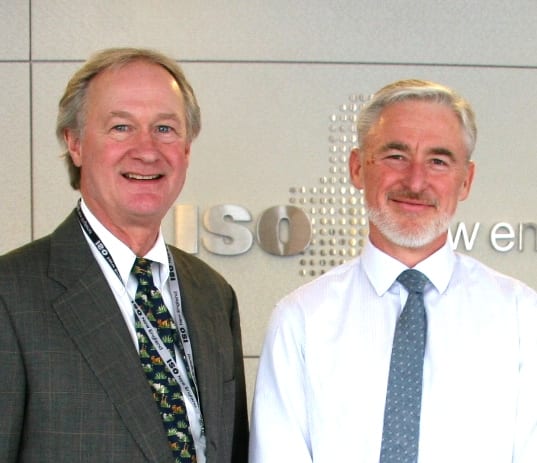New England Governors continue their heavy focus on energy issues in 2014
ISO-NE summarizes major themes from the State of the
State Addresses
During January and February 2014, each of the six New England governors gave a State of the State Address highlighting the many energy challenges facing the region.
These challenges include:
- Addressing the increased role natural gas plays in generating electricity
- Developing additional energy infrastructure and expanding energy trade with Eastern Canada
- Climate change and protecting valuable natural resources
- Integrating cost-effective renewable energy
- Controlling electricity costs
The governors’ addresses came weeks after their historic announcement to cooperate on an energy initiative designed to bring affordable, cleaner, and more reliable energy to homes and businesses across the region. In a joint statement issued in December 2013, the governors agreed to work together, in coordination with ISO New England and through the New England States Committee on Electricity, to advance a regional energy infrastructure initiative that expands electric transmission and natural gas pipeline capacity in New England. (See “New England Governors announce proposal to expand regional energy infrastructure.”)
ISO New England has long-identified the region’s reliance on natural gas for power generation and the associated need for additional energy infrastructure as one of the most pressing risks to reliable system operations. The ISO is encouraged by the steps being taken by the states to address these issues and has agreed to provide technical support and other assistance to facilitate their initiative. (See the ISO’s 2014 Regional Electricity Outlook which describes grid challenges and solutions underway.)
State-by-state rundown
Here is a look at each governor’s priorities as identified in the State of the State Addresses. (See also, “President Obama touches on energy priorities in annual State of the Union address.”)
Connecticut
Connecticut Governor Dannel P. Malloy’s February 6 address highlighted the development of a first-ever Comprehensive Energy Strategy for the state of Connecticut, with a planning horizon to 2050. According to Governor Malloy, the strategy will bring “cheaper, cleaner, and more reliable energy to Connecticut” and provide a foundation for better informed policy, legislation, and regulation.
When the strategy was released in February 2013, Governor Malloy said that Connecticut residents and businesses have paid too high a price for energy to heat their homes, fuel their vehicles, and power their businesses. To reduce energy bills and improve the state’s economic competitiveness, Governor Malloy stressed the importance of expanding energy efficiency and adding to the portfolio of energy options available to consumers, particularly natural gas for home heating.
Governor Malloy credited the new Comprehensive Energy Strategy in helping the state achieve a top-five national ranking in the 2013 State Energy-Efficiency Scorecard by the American Council for an Energy-Efficient Economy (ACEEE).
Maine
Maine Governor Paul LePage dedicated a significant portion of his February 4 address to energy issues, stressing the importance of lowering energy costs for homeowners and businesses. According to Governor LePage, Maine residents spend nearly double the national average on home heating. To help Maine families, Governor LePage explained that more funding is now available to help residents convert to more affordable heating systems, including energy-efficiency improvements and natural gas systems.
Governor LePage highlighted the work his administration is doing to reduce electricity costs and attract more business. Since he took office in 2011, Governor LePage has been an ardent supporter of expanding natural gas pipeline capacity to take full advantage of low-cost gas supplies from the Marcellus Shale.
In addition to expanding the natural gas system, Governor LePage emphasized the vast clean-energy resources available in neighboring Quebec, stating, “Our neighbors in Quebec have the best clean-energy resources on the planet. My administration is fighting for access to this cost-effective and clean source of electricity along with the rest of New England.” Governor LePage made clear, however, that he does not favor one form of energy over another and is most concerned about reducing energy costs for Maine residents and businesses.
Massachusetts
Governor Deval Patrick began his January 28 address highlighting Massachusetts’ first-in-the-nation ranking with regard to student achievement, economic competitiveness, health-care coverage, and energy efficiency. In 2013, Massachusetts ranked #1 on ACEEE’s State Energy-Efficiency Scorecard for the third year in a row based on its sustained commitment to energy efficiency. While Governor Patrick has been a strong supporter of energy efficiency, he has also advocated for continued growth in renewable energy, particularly solar photovoltaics. Last year, after meeting its initial goal of installing 250 megawatts (MW) of solar power in the state, Governor Patrick set a new goal for Massachusetts: 1,600 MW of solar power installed in the state by 2020.
After the New England Governors and Eastern Canadian Premiers’ (NEG-ECP) Annual Conference in September 2013, Governor Patrick commended the regional energy efforts of the New England governors and affirmed his state’s commitment to energy efficiency and cost-effective, low-carbon, clean energy trade opportunities between New England and Canada.
New Hampshire
Governor Maggie Hassan used her February 6 address to emphasize the need to reduce energy costs while conserving the natural resources that drive New Hampshire’s tourism industry. Governor Hassan identified two key initiatives that will help achieve these goals. The first is the development of the state’s long-term energy strategy, which she hopes will promote fuel diversity, reliability, and lower costs. The second initiative is her collaboration with the other New England governors to improve energy infrastructure. Governor Hassan stated that new pipeline projects are needed to increase the supply of natural gas in the region and reduce energy costs. She noted that “the regional grid operator, along with our utilities and pipeline owners” are working to increase the supply of natural gas, as well.
Finally, Governor Hassan highlighted the role of conservation and energy efficiency in ensuring that New Hampshire achieves its energy goals without diminishing the state’s natural beauty.
Governor Hassan will host the next meeting of the NEG-ECP this fall in New Hampshire.
Rhode Island

Rhode Island Governor Lincoln Chafee began his January 15 address expressing how proud he is that Rhode Island is becoming a better place to live, work, and raise a family. He cited the successful steps the state government and his administration have taken to preserve and protect the state’s environmental resources and reduce the harmful effects of climate change.
Governor Chafee also stressed the serious challenges New England faces in the energy sector. For Chafee, the primary challenges are cost and climate change. Chafee noted that, for these reasons, he is working with the other five New England governors and five Eastern Canadian Premiers “to achieve collectively what no single state or province can accomplish on its own—to build out our transmission lines and pipelines—so we can tap into clean, affordable and reliable hydropower, clean wind and solar power, as well as ensure that we have adequate natural gas to contain our electric costs.” According to Governor Chafee, who co-chaired the September 2013 NEG-ECP meeting in Québec, New England has “the potential to make this region the low-cost green energy capitol of North America.”
Vermont
Vermont Governor Peter Shumlin dedicated the majority of his January 8 address to issues unrelated to energy, but made clear that all Vermonters deserve to live in a state “where we have a clean environment with a bright, renewable energy future.” Climate change and renewable energy development have been top priorities for the Shumlin administration. Last summer, Governor Shumlin communicated strong support for President Obama’s Climate Action Plan, which focuses on cutting carbon pollution from power plants and deploying more renewable energy. According to Governor Shumlin, the President’s plan to boost energy efficiency and renewable energy will help the country “meet its obligation to fight climate change while providing jobs and saving money on our energy bills.”
In a letter sent to ISO New England in July 2013, Governor Shumlin called upon the ISO to partner with the states to help reduce greenhouse gas emissions and integrate renewable energy resources into the electric grid. Governor Shumlin emphasized Vermont’s preference for renewable resources and urged the ISO to consider the clean energy goals of Vermont and the broader region when operating the electric grid. In its response, the ISO highlighted its strong track record of facilitating the New England states’ goals of integrating renewable energy resources. In fact, the ISO has facilitated the successful integration of over 700 MW of wind generation in the region, and many more renewable energy projects can be found in the ISO’s Generator Interconnection Queue.
Staying informed
ISO New England’s External Affairs team will continue to monitor the New England governors’ efforts to further their regional energy infrastructure initiative, as well as their partnership with the Eastern Canadian Premiers to increase cost-effective clean energy trade opportunities between New England and Canada. These issues and others are expected to be addressed during the NEG-ECP Annual Conference in New Hampshire this July.
- Categories
- Inside ISO New England
- Tags
- new england states, renewable resources, wholesale prices



